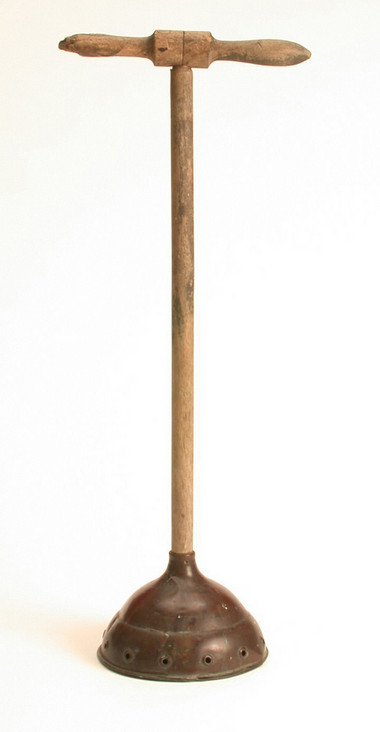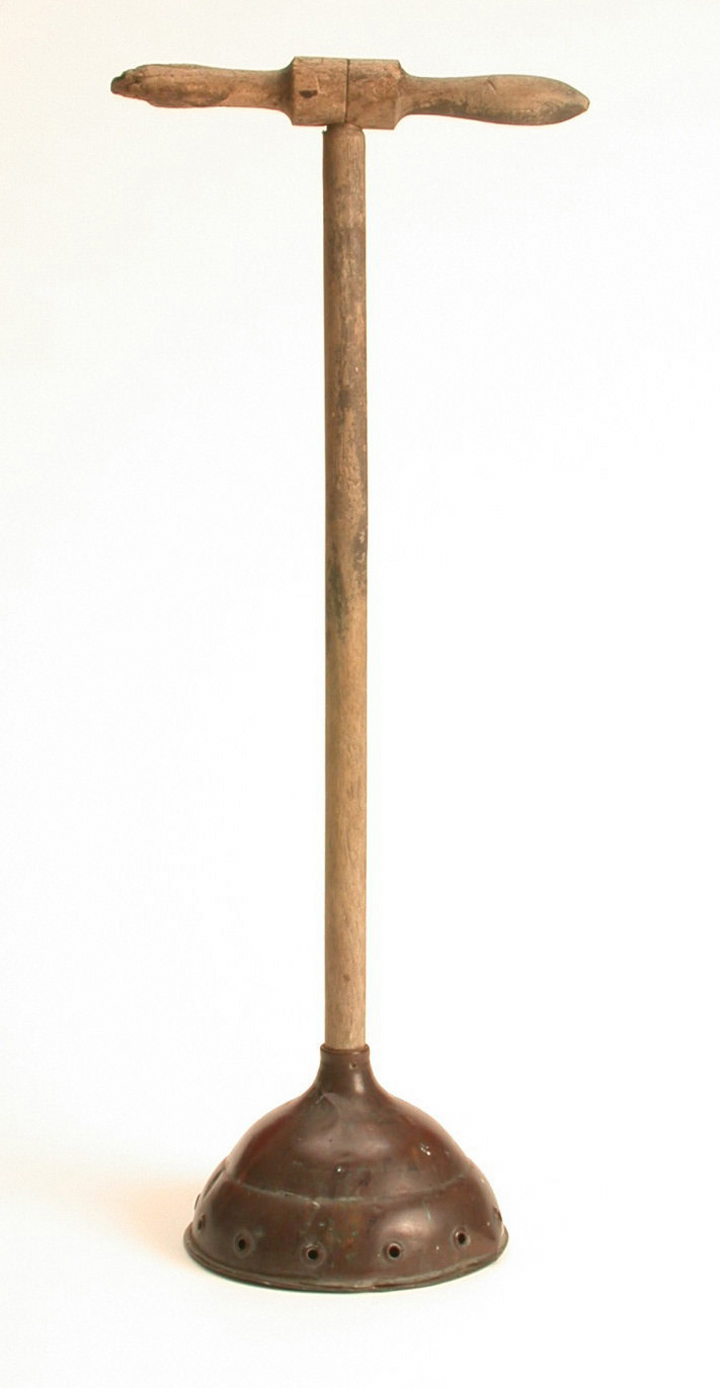Posser, Victorian, Original
Doing the laundry used to be a tiring and time-consuming chore. Piped water in homes was unusual before the late 19th century, so washing and drying laundry was done outside, except in wealthy households that had their own laundry rooms. Water had to be carried from a river or standpipe and was usually used cold, as it would be expensive and difficult to heat. Clothes had to be soaked, beaten and rinsed by hand, and then laid out to dry. The posser was an implements used in the 19th century, and until the mid 20th century, to make doing the laundry easier.
Washing was placed in water in a large tub and pounded with the posser using vertical movements. Some possers have a long handle without a cross-piece. The one shown here, however, has quite a short wooden handle (about 55 cm) and a wooden cross-piece that would have helped give a twisting movement. The copper dome of the posser is concave on its underneath side. This caused some suction, making the job easier. The rim and the underneath side of the dome are perforated at regular intervals.
Early possers were made of solid or perforated wood. Using copper for the dome meant that the posser could be mass-produced.
The word posser comes from the Middle English word 'poss', which means to pound or to beat.
Washing was placed in water in a large tub and pounded with the posser using vertical movements. Some possers have a long handle without a cross-piece. The one shown here, however, has quite a short wooden handle (about 55 cm) and a wooden cross-piece that would have helped give a twisting movement. The copper dome of the posser is concave on its underneath side. This caused some suction, making the job easier. The rim and the underneath side of the dome are perforated at regular intervals.
Early possers were made of solid or perforated wood. Using copper for the dome meant that the posser could be mass-produced.
The word posser comes from the Middle English word 'poss', which means to pound or to beat.

Height:71cm

Height:71cm

Doing the laundry used to be a tiring and time-consuming chore. Piped water in homes was unusual before the late 19th century, so washing and drying laundry was done outside, except in wealthy households that had their own laundry rooms. Water had to be carried from a river or standpipe and was usually used cold, as it would be expensive and difficult to heat. Clothes had to be soaked, beaten and rinsed by hand, and then laid out to dry. The posser was an implements used in the 19th century, and until the mid 20th century, to make doing the laundry easier.
Washing was placed in water in a large tub and pounded with the posser using vertical movements. Some possers have a long handle without a cross-piece. The one shown here, however, has quite a short wooden handle (about 55 cm) and a wooden cross-piece that would have helped give a twisting movement. The copper dome of the posser is concave on its underneath side. This caused some suction, making the job easier. The rim and the underneath side of the dome are perforated at regular intervals.
Early possers were made of solid or perforated wood. Using copper for the dome meant that the posser could be mass-produced.
The word posser comes from the Middle English word 'poss', which means to pound or to beat.
Washing was placed in water in a large tub and pounded with the posser using vertical movements. Some possers have a long handle without a cross-piece. The one shown here, however, has quite a short wooden handle (about 55 cm) and a wooden cross-piece that would have helped give a twisting movement. The copper dome of the posser is concave on its underneath side. This caused some suction, making the job easier. The rim and the underneath side of the dome are perforated at regular intervals.
Early possers were made of solid or perforated wood. Using copper for the dome meant that the posser could be mass-produced.
The word posser comes from the Middle English word 'poss', which means to pound or to beat.




















